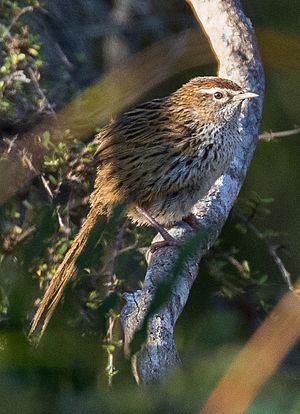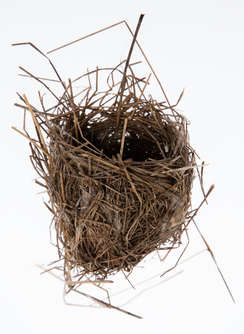New Zealand fernbird facts for kids
Quick facts for kids New Zealand fernbird |
|
|---|---|
 |
|
| Conservation status | |
| Scientific classification | |
| Genus: |
Poodytes
|
| Species: |
punctatus
|
| Synonyms | |
|
Bowdleria punctata |
|
The New Zealand fernbird or simply fernbird (Poodytes punctatus) is an insectivorous bird endemic to New Zealand. In the Māori language, it is named kōtātā or mātātā.
Taxonomy
The New Zealand fernbird was described by the French zoologists Jean Quoy and Joseph Gaimard in 1832 from a specimen collected in Tasman Bay / Te Tai-o-Aorere, South Island, New Zealand. They coined the binomial name, Synallaxis punctata.
There are five subspecies:
- B. p. punctata (South Island fernbird)
- B. p. vealeae (North Island fernbird)
- B. p. stewartiana (Stewart Island fernbird)
- B. p. wilsoni (Codfish Island fernbird)
- B. p. caudata (Snares fernbird)
The related Chatham fernbird (Poodytes rufescens), which, became extinct around 1900, was sometimes treated as a subspecies of this species.
Description
The New Zealand fernbird is a rich brown above and white below, with brown spots on both the throat and breast. Early settlers called it the "swamp sparrow" no doubt because of its colouration. The tail feathers are thin, dark brown, and spine-like. The birds reach a length of 18 cm (7 in) – as measured from tip of beak to end of tail. However, almost half of that is tail.
Ecology

The New Zealand fernbird is a ground-dwelling bird, and is a reluctant flier, travelling mainly on foot or in occasional short flights of less than 15 metres. In the 19th century, Buller described it as "one of our most common" (birds) but it has been adversely affected by the subsequent widespread destruction of its natural wetland habitat following European settlement and is now rare.
The birds nest in sedges or other vegetation close to the ground, making a deep woven cup of dried rushes lined with feathers. Breeding occurs from September to February, producing clutches of 2-3 pinkish-white eggs with brown or purple speckles. The Māori phrase "te whare o te mātātā" (a fernbird's house) describes a woven flax cape, made to keep out the weather; a testament to the design and strength of the nest.
Place in Māori culture
Māori revered the fernbird as an "oracle" or "wise bird" (Manu tohu). The calls of the bird were interpreted as heralding success or failure in daily activities such as fishing but on a more serious level could also portend prosperity and health or disaster and death.
See also
 In Spanish: Yerbera maorí para niños
In Spanish: Yerbera maorí para niños


